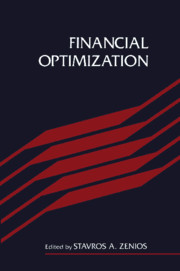Book contents
- Frontmatter
- Contents
- List of contributors
- Foreword
- Preface
- Acknowledgments
- Part I General overview
- 1 Some financial optimization models: I Risk management
- 2 Some financial optimization models: II Financial engineering
- 3 New “financial market equilibrium” results: implications for practical financial optimization
- 4 Empirical tests of biases in equity portfolio optimization
- Part II Models
- Part III Methodologies
- Index
2 - Some financial optimization models: II Financial engineering
Published online by Cambridge University Press: 09 February 2010
- Frontmatter
- Contents
- List of contributors
- Foreword
- Preface
- Acknowledgments
- Part I General overview
- 1 Some financial optimization models: I Risk management
- 2 Some financial optimization models: II Financial engineering
- 3 New “financial market equilibrium” results: implications for practical financial optimization
- 4 Empirical tests of biases in equity portfolio optimization
- Part II Models
- Part III Methodologies
- Index
Summary
Introduction
In this chapter we address the use of optimization models in financial engineering. We give this term to the process of creating new packages of old risk attributes. By repackaging and stripping risk attributes from existing instruments the financial engineer improves the marketability of the products and fits the needs of individual investors. Financial engineering also takes a service role in financial operations. For example, in order to obtain an AAA rating on an issue certain properties should hold under both best- and worst-case scenarios. Optimization models could automate the process of analyzing the scenarios.
This chapter is organized as follows: section 2 discusses three models from financial engineering and section 3 provides a brief overview of existing solution methodologies. Emphasis is placed in this section on the availability and capabilities of software for the solution of the optimization models presented earlier. It aims to convey a first exposure of the techniques to financial analysts, and may have little to offer to an operations research expert. An appendix provides an optimization model for the estimation of the term structure of interest rates, and explains Monte Carlo simulation techniques for generating interest-rate scenarios. Models like the one described here are often used to generate key input data to several of the optimization models discussed in both chapter 1 and this one.
Information
- Type
- Chapter
- Information
- Financial Optimization , pp. 37 - 71Publisher: Cambridge University PressPrint publication year: 1993
Accessibility standard: Unknown
Why this information is here
This section outlines the accessibility features of this content - including support for screen readers, full keyboard navigation and high-contrast display options. This may not be relevant for you.Accessibility Information
- 12
- Cited by
